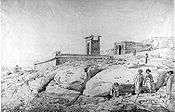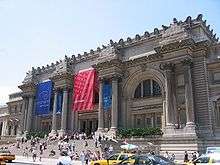Temple of Dendur
The Temple of Dendur (Dendoor in nineteenth century sources) is an Ancient Egyptian temple that was built by the Roman governor of Egypt, Petronius, around 15 BC and dedicated to Isis, Osiris, as well as two deified sons of a local Nubian chieftain, Pediese ("he whom Isis has given") and Pihor ("he who belongs to Horus").[1] The temple was commissioned by Emperor Augustus of Rome and has been exhibited in the Metropolitan Museum of Art in New York since 1978.
Architecture and artwork
The temple is constructed from sandstone and measures 25 meters (82 feet) from the front stone gate to its rear as well as 8 meters (26 feet) from its lowest to its highest point. A 30 meters (98 feet) cult terrace overlooks the Nile.[1] From the gate, two flanking walls ran around the temple and isolated the structure from the cult terrace and the Nile river.[1] The temple is partly decorated with reliefs: the temple base is decorated with carvings of papyrus and lotus plants growing out of the water of the Nile, which is symbolized by depictions of the god Hapy. Over the temple gate as well as over the entrance to the temple proper, depictions of the Winged sun disk of the sky god Horus represent the sky. This motif is repeated by the vultures depicted on the ceiling of the entrance porch. On the outer walls, Emperor Augustus is depicted as a pharaoh making offerings to the deities Isis, Osiris, and their son Horus. The subject is repeated in the first room of the temple, where Augustus is shown praying and making offerings. Augustus is identified as "Caesar" (actually, "Qysrs", which is based on "Kaisaros", the Greek version of Caesar). He is also called "Autotrator", an alteration of autokrator, or autocrat, the Greek equivalent of imperator, one of the emperor's titles. This misspelling seems to be deliberate, in order to achieve more symmetry in the hieroglyphs. In some other parts of the temple, however, the emperor is simply called "Pharaoh". The middle room, which was used for offerings, and the sanctuary of Isis at the rear of the temple are undecorated but for reliefs on the door frame and backwall of the sanctuary. The latter shows Pihor and Pedesi as young gods worshiping Isis and Osiris respectively. The 6.55 by 13 meters (21.5 by 42.7 feet) temple house is modest but well executed in design with two front columns, an offering hall and a sanctuary with a statue niche.[1] A crypt was also built into the rear wall while a rock chamber in the nearby cliffs may have represented the tombs of Pediese and Pihor who were said to have drowned in the Nile river.[1]
In the 19th century, graffiti were left on the temple walls by visitors from Europe. One of the most prominent pieces of graffiti ("A L Corry RN 1817", at eye level to the left as one enters the temple) was left by the British naval officer and later Rear Admiral Armar Lowry Corry. Another inscription was left by the Italian egyptologist Girolamo Segato.
Relocation


The temple was dismantled and removed from its original location (modern name: Dendur, ancient name: Tuzis, about 80 kilometers (50 miles) south of the town of Aswan) in 1963. This was accomplished as part of a wider UNESCO project,[2][3] in order to save significant sites from being submerged by Lake Nasser, following construction of the Aswan High Dam.[1] In recognition of the American assistance in saving various other monuments threatened by the dam's construction, Egypt presented the temple and its gate as a gift to the United States of America, represented by Jacqueline Kennedy among others, in 1965. The stone blocks of the temple weighed more than 800 tons in total with the largest pieces weighing more than 6.5 tons. They were packed in 661 crates and transported to the United States by the freighter m/v Concordia Star. In the United States, several institutions made bids for housing the temple, in a competition that was nicknamed the "Dendur Derby" by the press. Alternative plans proposed re-erecting the temple on the banks of the Potomac River in Washington, D.C. or on the Charles River in Boston. However, these suggestions were dismissed because it was feared that the temple's sandstone would suffer from the outdoor conditions. On April 27, 1967, the temple was awarded to The Metropolitan Museum of Art, where it was installed in the Sackler Wing in 1978. Inside the Sackler Wing, designed by the architects Kevin Roche, John Dinkeloo, and associates, a reflecting pool in front of the temple and a sloping wall behind it, represent the Nile and the cliffs of the original location. The glass on the ceiling and north wall of the Sackler is stippled in order to diffuse the light and mimic the lighting in Nubia.
In Popular Culture
- In the Rick Riordan novel The Red Pyramid, protagonists Carter and Sadie Kane flee into the Metropolitan Museum of Art and search for the Temple of Dendur on the orders of their friend Bast. As the scorpion goddess Serqet attacks, the Kanes makes a stand in front of the temple, holding Serqet and her scorpion army off long enough to use the temple to open a portal and escape.
See also
The four temples donated to countries assisting the relocation are:
- Temple of Debod (Madrid, Spain)
- Temple of Dendur (Metropolitan Museum of Art, New York, United States)
- Temple of Taffeh (Rijksmuseum van Oudheden in Leiden, the Netherlands)
- Temple of Ellesyia (Museo Egizio, Turin, Italy)
References
- 1 2 3 4 5 6 Arnold, Dieter (1999). Temples of the Last Pharaohs. Oxford University Press. p. 244.
- ↑ Monuments of Nubia-International Campaign to Save the Monuments of Nubia World Heritage Cmmittee, UNESCO
- ↑ The Rescue of Nubian Monuments and Sites, UNESCO
External links
| Wikimedia Commons has media related to Temple of Dendur. |
- Article at the Metropolitan Museum's web site
- Digitized material related to the Temple of Dendur in the Digital Collections from The Metropolitan Museum of Art Libraries
- Article in Saudi Aramco World
Coordinates: 23°22′59″N 32°57′00″E / 23.38306°N 32.95000°E
